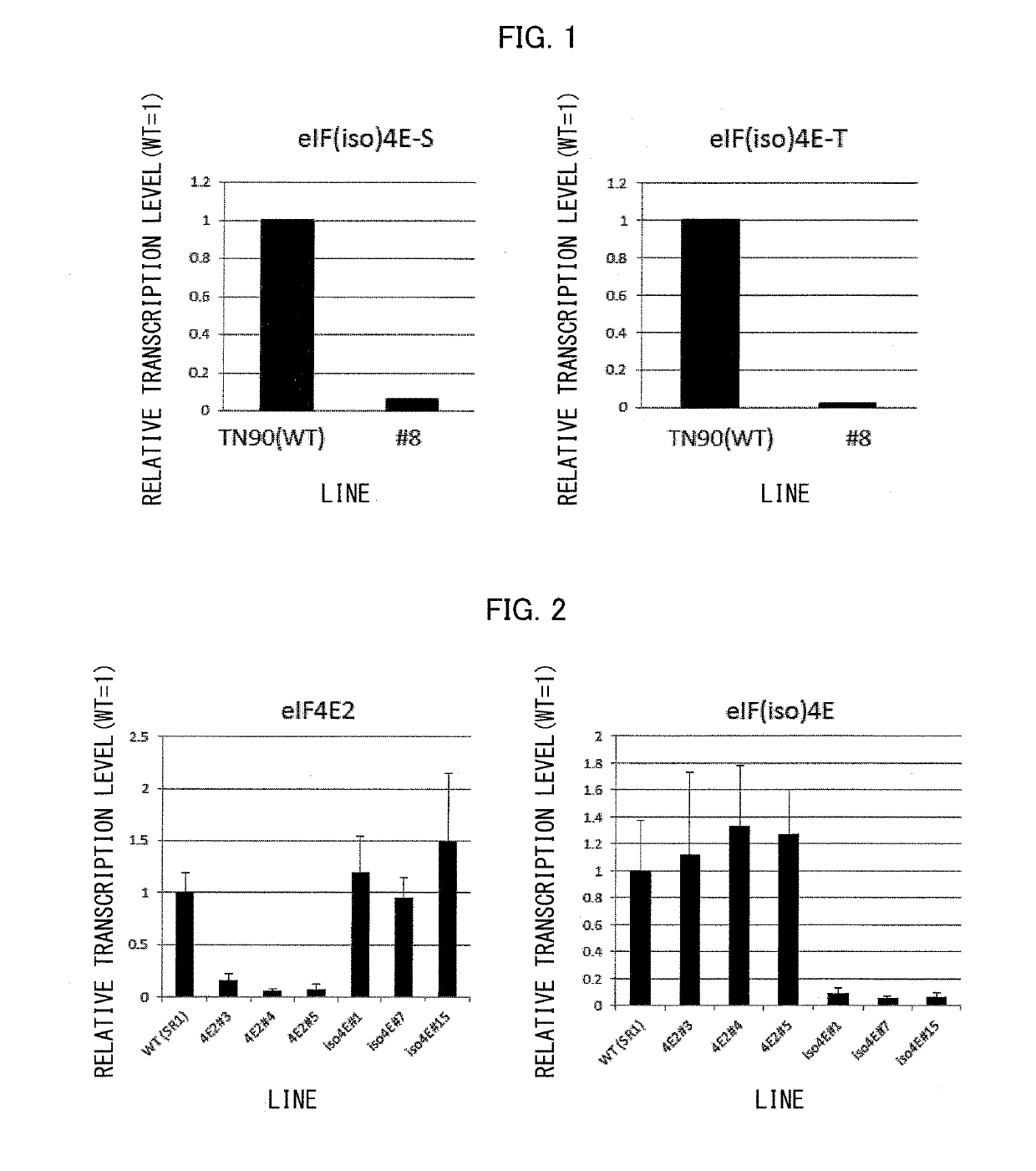Virus-resistant tobacco and breeding method therefor
a tobacco and virus-resistant technology, applied in the field of virus-resistant tobacco, can solve the problems of affecting the quality and yield of leaf tobacco, and reducing the yield of leaf tobacco
- Summary
- Abstract
- Description
- Claims
- Application Information
AI Technical Summary
Benefits of technology
Problems solved by technology
Method used
Image
Examples
example 1
[0301](Gene Sequence Acquisition)
[0302][eIF4E2 gene]
[0303]GenBank database (http: / / www.ncbi.nlm.nih.gov / pubmed) was searched to acquire, as translation initiation factors of tobacco (N. tabacum), the mRNA base sequence of eIF4E assigned GenBank accession number EB451717, the mRNA base sequence of eIF4E assigned GenBank accession number KF155696, and the mRNA base sequence of eIF4E assigned GenBank accession number KM202068. These eIF4Es were named eIF4E2. These eIF4Es had a homology of 70% to 74% with respect to eIF4E1 (accession number: AY702653, Non-Patent Literature 19). By BLAST analysis using the Whole-genome shotgun contigs (WGS) of N. tomentosiformis and N. sylvestris on the GenBank database, it was determined that eIF4E2 assigned accession number EB451717 and eIF4E2 assigned accession number KF155696 are derived from N. sylvestris, and eIF4E2 assigned accession number KM202068 is derived from N. tomentosiformis. EB451717 (whose protein coding region sequence is from the 87th...
example 2
[0333](Selection of Tobacco Mutant Having Mutation in eIF4E2-S Gene, eIF(Iso)4E-S Gene, and eIF(Iso)4E-T Gene)
[0334]The variety TN90 was used as tobacco in which the function of the eIF4E2-S gene was suppressed. Furthermore, the eIF(iso)4E mutant of Example 1 was used as tobacco in which the functions of both the eIF(iso)4E-S gene and the eIF(iso)4E-T gene were suppressed. The eIF(iso)4E mutant has homozygous mutations (nonsense mutations) in both the eIF(iso)4E-S gene and the eIF(iso)4E-T gene such that transcription of the eIF(iso)4E-S gene and transcription of the eIF(iso)4E-T gene are suppressed (Patent Literature 5). Note that the genotype of the eIF4E2 gene and the eIF(iso)4E gene in each individual is represented in the following manner: eIF4E2-SSTT / eIF(iso)4E-SSTT. For example, the genotype of TN90 is eIF4E2-ssTT / eIF(iso)4E-SSTT, and the genotype of the eIF(iso)4E mutant is eIF4E2-SSTT / eIF(iso)4E-sstt.
[0335]An eIF4E2-ssTT / eIF(iso)4E-sstt line and an eIF4E2-ssTT / eIF(iso)4E-SS...
PUM
| Property | Measurement | Unit |
|---|---|---|
| concentration | aaaaa | aaaaa |
| concentration | aaaaa | aaaaa |
| concentrations | aaaaa | aaaaa |
Abstract
Description
Claims
Application Information
 Login to View More
Login to View More - R&D
- Intellectual Property
- Life Sciences
- Materials
- Tech Scout
- Unparalleled Data Quality
- Higher Quality Content
- 60% Fewer Hallucinations
Browse by: Latest US Patents, China's latest patents, Technical Efficacy Thesaurus, Application Domain, Technology Topic, Popular Technical Reports.
© 2025 PatSnap. All rights reserved.Legal|Privacy policy|Modern Slavery Act Transparency Statement|Sitemap|About US| Contact US: help@patsnap.com

